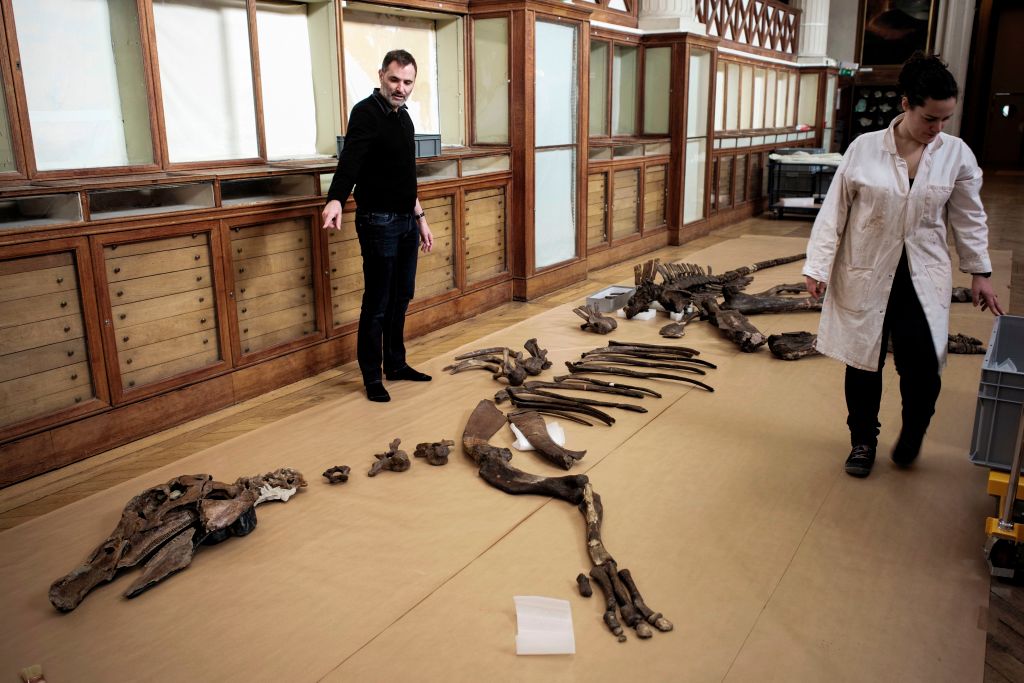Summary of Chilean Fossil Reveals a New Duck-Billed Dinosaur Species, Study Shows:
Researchers have discovered a new dinosaur species called Gonkoken nano Chilean Patagonia. This species is a member of the Hadrosauridae family, also known as duck-billed dinosaurs, characterized by their flat and elongated snouts and rows of teeth. This discovery is significant because it is the first hadrosaur in Chile and one of the few known from the southern hemisphere. It is also one of the oldest hadrosaurs known, dating back about 72 million years. The discovery sheds new light on the origin and evolution of hadrosaurs and their distribution across continents. It highlights the importance of exploring new fossil sites and regions and the need for collaboration in preserving and studying natural heritage.
– The Chilean Fossil Reveals a New Duck-Billed Dinosaur Species, Study Shows
– Dinosaurs are diverse and fascinating animals, with over 1,000 species identified.
– Many dinosaurs, especially in the southern hemisphere, remain poorly known or undiscovered due to scarce and fragmentary fossil records.
– Gonkoken nanoi is a new species of hadrosaur, a duck-billed dinosaur, discovered in Chile.
– Hadrosaurs were successful and widespread dinosaurs during the Late Cretaceous period.
– The discovery of Gonkoken nanoi is significant because it is the first hadrosaur found in Chile and one of the few known from the southern hemisphere.
– It is also one of the oldest and most southern hadrosaurs ever found.
– The discovery sheds light on the origin and evolution of hadrosaurs and their distribution across continents.
– It highlights the importance of exploring new fossil sites and regions to expand our knowledge of dinosaur diversity and history.
– Chile’s challenging geological conditions make it a promising source for new dinosaur discoveries.
– Collaboration and support among paleontologists, local communities, and authorities are essential for preserving and studying natural heritage.
Dinosaurs have long captivated our imaginations as some of the most fascinating creatures ever roamed the Earth. With over 1,000 species identified so far, their diversity is astounding. However, many dinosaurs remain poorly known or completely undiscovered, particularly in the southern hemisphere, where fossil records are scarce and incomplete. Recent research has shed light on a new and unique species of dinosaur, providing exciting insights into the world of these ancient creatures.
Meet Gonkoken Nano, a new hadrosaur species commonly known as a duck-billed dinosaur. These dinosaurs are characterized by their flat and elongated snouts, resembling ducks or geese bills. They also possess rows of teeth that form a grinding surface for chewing rigid plant material. Hadrosaurs were among the most successful and widespread dinosaurs during the Late Cretaceous period, from about 100 to 66 million years ago.
Gonkoken nano I was discovered by researchers from Chile and Germany, who published their findings in the journal Science Advances. The researchers analyzed fragments of bones and teeth collected in 2013 from a site near Torres del Paine National Park in Chilean Patagonia. By comparing these specimens with other hadrosaur fossils from around the world, they concluded that Gonkoken nanoi belonged to a previously unknown species.
Estimates suggest that Gonkoken nano weighed a metric ton and reached heights of up to four meters (13 feet). Its name derives from the Tehuelche language, spoken by the native people of Patagonia, and translates to “similar to a wild duck or a swan.” This name reflects the shape of its snout and its southern location, highlighting the uniqueness of this discovery.
This discovery’s significance goes beyond identifying a new dinosaur species. It is particularly remarkable due to the rarity of dinosaurs found in Chile. The country has a poor fossil record of dinosaurs due to its mountainous terrain and volcanic activity that has erased or buried most ancient sediments. Most of the dinosaur fossils in Chile belong to marine reptiles or birds, discovering new species extraordinary.
In addition to being a rare find in Chile, Gonkoken nanoi is one of the few hadrosaurs known from the southern hemisphere and the southernmost one ever found. Most hadrosaurs are known from North America, Asia, and Europe, where they were diverse and abundant. Only a handful of hadrosaur fossils have been discovered in South America, Australia, and Antarctica, and they are typically incomplete or poorly preserved. The discovery of Gonkoken nano fills a significant gap in our understanding of hadrosaurs’ distribution and evolution.
Notably, Gonkoken nanoi is one of the oldest known hadrosaur species, dating back approximately 72 million years. Most hadrosaurs are younger than 70 million years old and belong to more advanced groups that possess specialized features such as crests or horns on their heads. Gonkoken nano belongs to an ancestral lineage of hadrosaurs that was more primitive and widespread. This finding provides valuable insights into the origin and evolution of hadrosaurs.
The discovery of Gonkoken nanoi has broader implications for paleontology and conservation efforts. It emphasizes the importance of exploring new fossil sites and regions to expand our knowledge of dinosaur diversity and history. Despite the challenging geological conditions in Chile, this discovery demonstrates the country’s potential as a source for new dinosaur discoveries. By collaborating with local communities and authorities, paleontologists can effectively preserve and study this unique natural heritage.
In conclusion, the recent discovery of Gonkoken nanoi, a new species of hadrosaur, in Chile significantly contributes to our understanding of dinosaurs. This finding adds to the knowledge of this diverse group of animals but also sheds light on their distribution and evolution. It highlights the need for continued exploration of new fossil sites and cooperation among paleontologists, local communities, and authorities. By doing so, we can unearth more ancient world secrets and ensure the preservation of our natural heritage.


